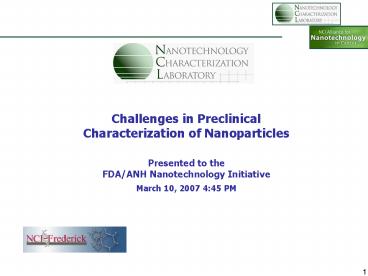Challenges in Preclinical Characterization of Nanoparticles - PowerPoint PPT Presentation
1 / 22
Title:
Challenges in Preclinical Characterization of Nanoparticles
Description:
Emory University and Georgia Institute of Technology, Atlanta, Ga. ... for biocompatibility-testing of nanomaterials intended for medical applications ... – PowerPoint PPT presentation
Number of Views:256
Avg rating:3.0/5.0
Title: Challenges in Preclinical Characterization of Nanoparticles
1
Challenges in Preclinical Characterization of
Nanoparticles Presented to the FDA/ANH
Nanotechnology Initiative March 10, 2007 445 PM
2
Massachusetts Institute of Technology, Cambridge,
Mass.
University of Washington, Seattle, Wash.
MIT-Harvard Center of Cancer Nanotechnology
Excellence, Cambridge, Mass.
Roswell Park Cancer Institute, Buffalo,
N.Y. State University of New York, Buffalo, N.Y.
University of Michigan, Ann Arbor, Mich.
University of California, San Francisco. Calif.
Northeastern University, Boston, Mass.
Massachusetts General Hospital, Boston, Mass.
Northwestern University, Evanston, Ill.
Virginia Commonwealth University, Richmond, Va.
University of Missouri, Columbia, Mo.
Washington University, St. Louis, Mo.
California Institute of Technology, Pasadena,
Calif.
University of North Carolina, Chapel Hill, N.C.
University of California, San Diego, Calif.
Emory University and Georgia Institute of
Technology, Atlanta, Ga.
The University of Texas M. D. Anderson Cancer
Center, Houston, Texas
The Sidney Kimmel Cancer Center, San Diego,
Calif.
Centers of Cancer Nanotechnology Excellence
(8) Cancer Nanotechnology Platform Partnerships
(12)
3
NCL Concept of Operations
NCL is a formal collaboration between NCI, FDA
and NIST
4
NCL Assay Cascade
- Physicochemical
- Size
- Shape
- Composition
- Molecular weight
- Surface chemistry
- Identity
- Purity
- Stability
- Solubility
- In Vitro
- Pharmacology
- Blood contact properties
- Immune cell function
- Cytotoxicity
- Mechanistic toxicology
- Sterility
- In Vivo
- ADME
- Safety
- Efficacy
http//ncl.cancer.gov/assay_cascade.asp
5
Physicochemical Characterization
- Physicochemical Parameters
- Composition
- Physical properties
- Chemical properties
- Identification
- Quality
- Purity
- Stability
Small molecules
- Elemental analysis
- Mass Spec
- NMR
- UV-Vis
- IR
- HPLC
- GC
- Polarimetry
Same parameters different/additional
characterization methods
http//ncl.cancer.gov/working_assay-cascade.asp
6
In Vitro Cascade
- Sterility
- Bacterial/Viral/Mycoplasma
- Endotoxin
- Cell Uptake/Distribution
- Cell Binding/Internalization
- Targeting
- Blood Contact Properties
- Plasma Protein Binding
- Hemolysis
- Platelet Aggregation
- Coagulation
- Complement Activation
- CFU-GM
- Leukocyte Proliferation
- Macrophage/Neutrophil Function
- Cytotoxic Activity of NK Cells
- Toxicity
- Phase I/II Enzyme Induction/Suppression
- Oxidative Stress
http//ncl.cancer.gov/working_assay-cascade.asp
7
ASTM Standards
- First voluntary consensus standards for
biocompatibility-testing of nanomaterials
intended for medical applications - E2524 (hemolysis), E2525 (CFU-GM inhibition),
E2526 (kidney and liver cytotox)
ASTM ILS 166
Standard Methods
8
RM 8011-8013
- NCI supported the production of NISTs colloidal
gold RM . - Au selected for calibration and biocompatibility
- 10nm, 30nm, and 60 nm diameters.
- Available as of January 08.
9
In Vivo Cascade
- Initial Disposition Study
- Tissue Distribution
- Clearance
- Half-life
- Immunotoxicity
- 28-day screen
- Immunogenicity (repeat dose tox study)
- Dose-Range Finding Toxicity
- Blood Chemistry
- Hematology
- Histopathology
- Gross Pathology
- Efficacy
- Therapeutic
- Imaging
Dual Radiolabels
Plasma Profile
http//ncl.cancer.gov/working_assay-cascade.asp
10
NCL Extramural Collaborators
11
Portfolio of Nanoparticles
- M. Kester (Penn State)
- E. Chang (Georgetown)
- R. Blumenthal (NCI)
- J. Nagy (Nanomed)
- J. Connor (Penn State)
- W. Zamboni (U. Pittsburgh)
- A. Miller (Imperial College London)
- Dendritic Nanotechnologies (DNT)
- Avidimer Therapeutics
- M. Brechbiel (NCI)
- E. Simanek (Texas AM)
Liposomes
Dendrimers
- S. Weiss (UCLA)
- Evident Technologies
- J. Barchi (NCI)
- NanoSpectra (Rice)
Quantum Dots
Gold nanoshells
- M. Amiji (Northeastern)
- Nanoscan
- CytImmune Sciences
- TedPella Inc.
- A. Wei (Purdue)
- K. Katti (U. Missouri)
Colloidal gold
Nanoemulsions
- US FDA
- Tego Bioscience
TiO2
- J. Ljubimova (Mt. Sinai)
- M. Amiji (Northeastern)
- N. Tarasova (NCI)
- D. Ferguson (U. Wisc)
- V. Torchilin (Northeastern)
- Carigent Therapeutics
Fullerenes
- Alnis
Polymers
Iron Oxide
12
Trends Biocompatibility
Nanoparticle Biocompatibility
()
Low
Cytotoxicity(Surface Reactivity)
RES Recognition
Solubility
Zeta Potential
0
Biliary Clearance ?
Renal Clearance
(EPR Effect)
()
High
1 nm
220 nm
Size(Rigid Core)
13
Trends Charge
Platelet Aggregation
Biocompatibility depends on surface charge.
14
Size Matters
Dendrimer-Based MRI Contrast Agents
Kobayashi and Brechbiel, Molecular Imaging,
21-10, 2003.
A difference in size as little as 2nm can
influence route of clearance
15
Size effects In Vitro
G3 G4 G5 G6
Biocompatibility depends on particle size.
16
Size in a Biological Context
30 nm Gold colloids
69 nm
31 nm
17
Solubility
TEM
Phagocytosis
Anionic Colloidal Gold Uptake Expected
PEGylated Gold Low/No Uptake Expected
Fluorescence assay
More than one method is often required to draw
conclusions
18
EDX Spectral Mapping
TEM
A
B
C
Ti
SEM
2 µm
O
C
Spectral mapping confirms the agglomerated
particles contain Ti and O.
19
Batch to Batch Variability
83
Hemolytic properties of two lots of the same
nanomaterial appear different
Hemolysis
Liposome Lot 1
Negative Control
Positive Control
Liposome Lot 2
20
Fullerene Chemoprotection
DF-1
DF-1 Mini
21
Characterization Challenges
- Parameters that influence biocompatibility
- Surface Charge
- Size
- Hydrophobicity/solubility
- Stability
- Importance of characterization
- Batch to batch variability
- Physical parameters greatly affect ADME/Tox
- Reference material, ASTM standards
- Each nanoparticle is unique!
22
Acknowledgements
NCL Scott McNeil, Ph.D. Anil Patri,
Ph.D. Marty Fritts, Ph.D. Marina Dobrovolskaia,
Ph.D. Stephan Stern, Ph.D. Arindam Dhar, M.D.,
Ph.D. Uma Ramalinga, Ph.D. Jeffrey D. Clogston,
Ph.D. Jiwen Zheng, Ph.D. Banu Zolnik,
Ph.D. Parag Aggarwal, Ph.D. Jennifer Hall,
Ph.D. Sarah Skoczen, M.S. Chris McLeland,
B.S. Tim Potter, B.S. Barry Neun, B.S. Jamie
Rodriguez, B.S. David Parmiter, B.A. Nader Ayub
Funded by NCI Contract N01-CO-12400































